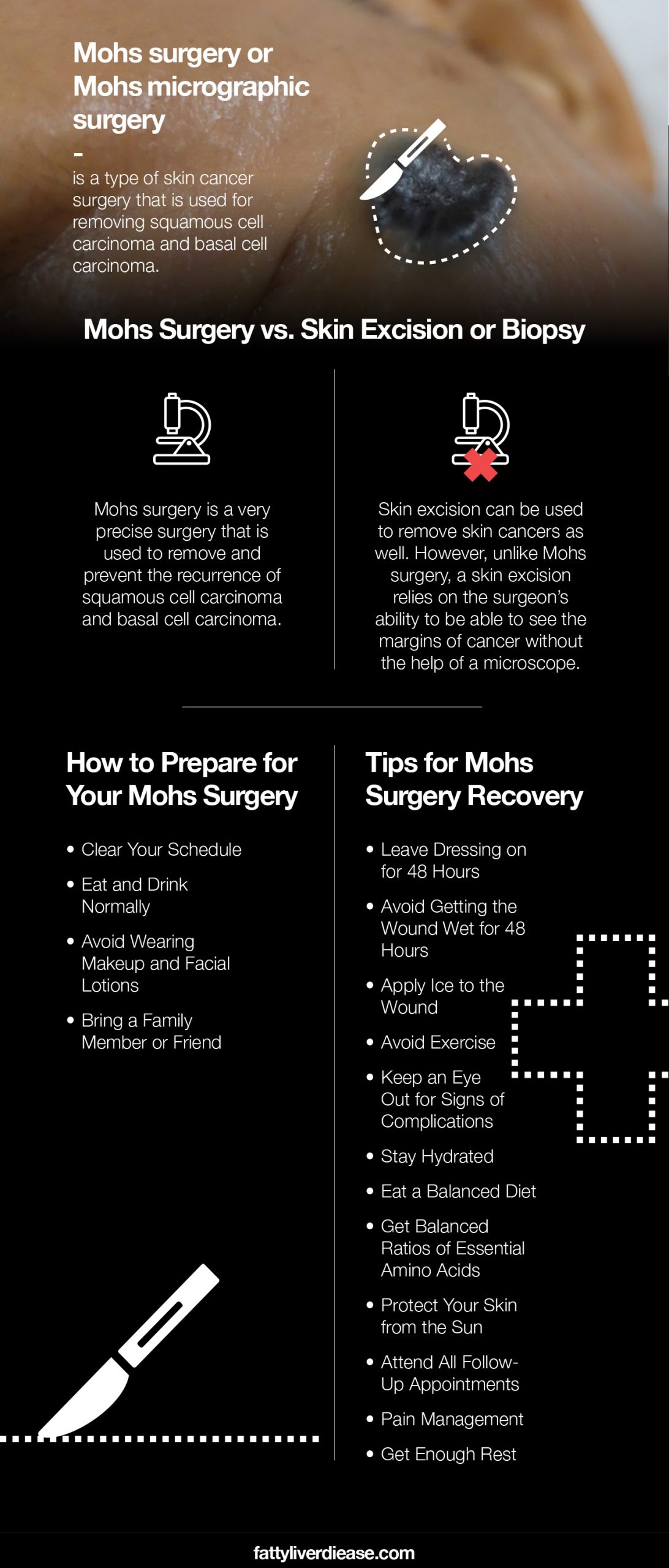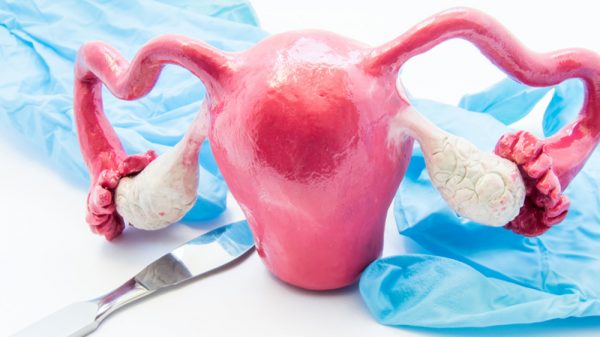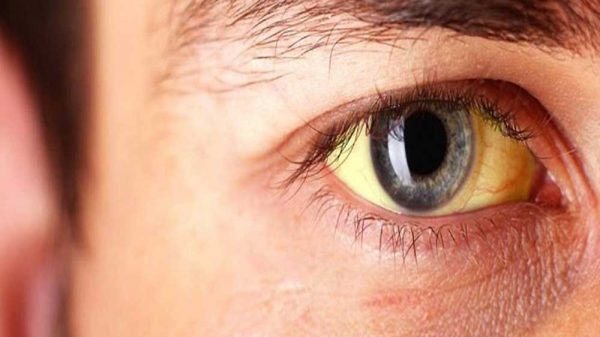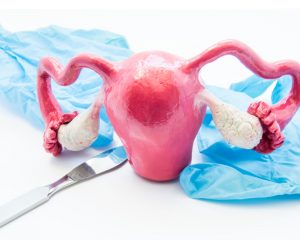Like all surgeries, Mohs surgery requires a period of recovery following the procedure. Here we go through what to expect from a Mohs surgery and recovery, as well as tips for fast Mohs surgery recovery. If you’re scheduled for Mohs surgery, then you’ve come to the right place. Keep reading to find out more about how to facilitate a quick and successful recovery following your Mohs surgery.
What Is Mohs Surgery?
Before we dive into what to expect during the procedure and recovery, let’s first discuss what a Mohs surgery is. Mohs surgery – or Mohs micrographic surgery – is a type of skin cancer surgery that is used for removing squamous cell carcinoma and basal cell carcinoma. Mohs surgery is the most precise and effective form of surgical procedure for removing skin cancer lesions. The procedure is designed to remove the entire cancerous area while also removing the least amount of skin tissue possible.
Can skin cancer come back after Mohs surgery? It’s possible, but the cure rate of skin cancer following Mohs surgery is much higher than for other procedures, such as regular skin excisions.
Mohs surgery is a highly specialized form of surgery that is performed by dermatologists who have completed a dermatology residency and trained in a specialized fellowship program on Mohs surgeries.
Mohs Surgery Procedure: What to Expect
When you go in for your Mohs surgery, it’s helpful to have an idea of how the procedure goes.
First, your surgeon will meet with you to go over the procedure to make sure you know what to expect and what the goal of the procedure is. The surgeon will likely use a pen to mark the area that requires surgery.
You will not require general anesthesia for the surgery, which makes both surgery preparation and recovery easier. Before the procedure, your surgeon will simply clean the surgical site and apply a local anesthetic. Because you are receiving local anesthesia and not general anesthesia, you will remain awake and alert throughout the duration of the procedure, though you will not feel any pain.
After the first area of skin is removed, the surgical site will be covered with a bandage and you will be asked to wait in a waiting area. The surgeon will then examine the margins of the removed area of skin under a microscope, to see if the margins contain cancerous cells. The goal is to see margins with no cancerous cells, which indicates that the entire cancerous area has been removed. If only cancerous cells are detected, this means that there are likely cancerous cells left on your skin and another procedure must be performed. You will then return to the operating room and the Mohs surgeon will remove another area of skin with slightly larger margins. The surgeon then examples the tissue again to look for both healthy cells and cancer cells. The procedure is repeated until the surgeon detects no cancerous cells in the sample, indicating that the entire cancerous area has been removed.
When the surgeon has determined that the whole cancerous lesion has been removed, it’s time to close up the remaining area of skin. The way the wound is left is highly dependent on the area of skin that needed to be removed. The surgeon will address the area of skin and tend to the wound in a way that results in minimal amounts of scaring. In some cases, the surgeon may elect to leave the wound as is, to let it recover naturally. In other cases, the surgeon will manipulate the skin surrounding the surgical site and secure it over the wound with stitches. In other cases, still, a skin graft from an inconspicuous area of the body will be used to minimize scarring throughout the recovery process.
In some cases, reconstructive surgery is needed after the initial surgery to further minimize scarring. Occasionally, in special cases, you may be referred to a plastic surgeon for reconstructive surgery. However, this is at the discretion of the Mohs surgeon, and most Mohs surgeries don’t require further intervention.
When Might Mohs Surgery Be Recommended?
Mohs surgery is an ideal procedure if you have certain types of skin cancer. Mohs surgery may be recommended if you have a squamous cell or basal cell carcinoma lesion on an area of sensitive skin, such as the lips, nose, eyelids, or other areas of facial skin. Mohs surgery may also be recommended if you’ve had previous skin excisions on any area of the body, and the cancerous lesion has returned following recovery.
How to Prepare for Your Mohs Surgery
Preparing properly for your Mohs surgery helps to make sure that the surgery goes smoothly, and you’re set up for recovery.
1. Clear Your Schedule
If you are scheduled for Mohs surgery, keep in mind that the length of the procedure may be unpredictable. As a result, it’s a good idea to clear your schedule and make sure that you don’t have any other obligations planned for the day. This takes stress off of you, and if the procedure ends up running longer than expected, you don’t need to worry about changing your plans.
2. Eat and Drink Normally
Because the Mohs surgery doesn’t require general anesthesia, you don’t need to restrict your food and beverage intake. The morning of your Mohs surgery, make sure to drink water, eat some breakfast, and take any prescribed medications as you normally would.
3. Avoid Wearing Makeup and Facial Lotions
The vast majority of Mohs surgery procedures take place on facial skin. When going into the clinic on the day of your surgery, avoid putting on makeup and facial lotions if possible. Makeup and lotions will need to be removed at the clinic, in order to ensure that the surgical site is as sterile as possible.
4. Bring a Family Member or Friend
Even though you’re not undergoing general anesthesia, it’s still possible that you still may feel tired after surgery. If you are undergoing a procedure near your eyes, the effects of the surgery may temporarily make it difficult to operate a vehicle, so it may be necessary to have your friend or family member drive you home. Either way, having a loved one there for you following surgery is helpful for support.
Mohs Surgery vs Skin Excision or Biopsy
Mohs surgery is a very precise surgery that is used to remove and prevent the recurrence of squamous cell carcinoma and basal cell carcinoma. Because Mohs surgery includes the examination of tissue samples until they show cancer-free healthy tissue, it nearly guarantees that all of the skin cancer will be removed.
Skin excision can be used to remove skin cancers as well. However, unlike Mohs surgery, a skin excision relies on the surgeon’s ability to be able to see the margins of cancer without the help of a microscope. This means that the cancer removal may or may not be successful, and it’s possible that some margins of the skin cancer may be left intact.
In contrast to both Mohs surgery and skin excision, a biopsy is a small tissue sample taken from the area of skin that looks questionable. The biopsy allows a health care professional to analyze the sample up close to look for markers of skin cancer. Biopsies are commonly used on areas of skin or moles that look suspicious and are also a common method of cancer diagnosis across all organ systems.
Tips for Mohs Surgery Recovery
Post-surgery wound care, lifestyle changes, and diet changes can help make sure that you make a full recovery with minimal scarring and reduced risk of cancerous skin lesions returning.
1. Leave Dressing on for 48 Hours
Following a Mohs surgery, the surgical site must heal. Regardless of whether there are stitches or an open area of skin, leaving the dressing on for 48 hours allows the skin to begin to recover and form a protective shield. This protective shield jump-starts the healing process and protects vulnerable, exposed skin from bacteria and other invaders. Removing the bandage too soon after the procedure may result in ripping the delicate layer of skin that has formed, which can delay recovery. After 48 hours, change the dressing according to your doctor’s instructions.
2. Avoid Getting the Wound Wet for 48 Hours
While the bandage is on the wound, try to avoid getting the area wet. Water on a healing wound can be irritating and impede the healing process. Plus, a wet bandage doesn’t provide protection and instead provides a perfect breeding ground for bacteria, which increases the chance of infection.
When can I shower after Mohs surgery? You can shower immediately following surgery, as long as you avoid getting the bandage wet. Most commonly, Mohs surgery will be performed on your face, making it easy to take a shower or bath without getting the surgical site wet.
3. Apply Ice to the Wound
Just like you would apply ice to a bump on your head, you will apply ice to your surgical wound. Be sure to protect the wound from direct contact with ice, to avoid irritation. Hold the ice cubes or ice pack to the covered wound and hold it for at most 10 minutes. Remember, your skin in this area is delicate. Holding ice directly on the wound for too long can be very painful and ultimately do more harm than good. Applying ice over the first couple days following the surgery will help address any swelling and bruising.
4. Avoid Exercise
In the first few days following surgery, it’s a good idea to avoid exercising. Engaging in exercise drives up the heart rate and blood pressure. Increased blood pressure may jeopardize the healing surgical site and increase the risk of swelling, redness, pain, and delayed recovery. Your physician may also recommend that you stay away from very rigorous exercise for about a week, in order to maximize recovery. This means that you should avoid strenuous activities like weightlifting, running, dancing, high-intensity interval training, or any intense form of aerobic exercise or strength training that may increase blood pressure and raise the risk of complications. However, after about a week, you should soon be able to return to your normal activities. Just make sure to clear your activities with your doctor.
5. Keep an Eye Out for Signs of Complications
Because Mohs surgery is a small, topical procedure, you aren’t at risk for serious or life-threatening complications. However, as with any procedure, bleeding and infections are potential complications. You may notice an issue with bleeding if blood soaks all the through the bandage. Keep in mind that you are at a higher risk of bleeding complications if you take blood thinners.
Signs of infection include oozing at the surgical site, redness and warmth around the surgical site, swelling, itching, and irritation. If you notice any signs or symptoms of complications, it’s important to call your doctor and take care of the issue as soon as possible.
6. Stay Hydrated
Staying hydrated is important for fighting any fatigue that you may experience following surgery by keeping your blood circulation up and by clearing out any waste products that may have built up within healing body tissues. Drinking plenty of water also allows the body to more easily circulate nutrients throughout the body so that they reach the wound and help support healing.
7. Eating a Balanced Diet
A balanced diet is important for promoting optimal wound repair. Even though a Mohs surgery won’t impact your daily life like a more invasive surgery would, it’s still important to follow a balanced diet to support quick and complete healing of the surgical site.
So, what exactly does it mean to eat a balanced diet? Generally, following a balanced diet means you’re getting whole foods from each food group.
It’s important to get plenty of fruits and veggies. Fresh produce is packed with vitamins, minerals, antioxidants, and fiber that help support the healing process. In particular, polyphenols and vitamin C help reduce inflammation and oxidative stress and support cellular repair. To encourage timely healing add plenty of fruits and veggies to your diet on a daily basis. Excellent food choices include produce like apples, blueberries, oranges, mango, cherries, carrots, tomatoes, beets, bell peppers, cucumber, spinach, kale, broccoli, and Brussels sprouts.
Whole grains, nuts, and seeds also provide an abundance of antioxidants, vitamins, and minerals that are vital for healing and repair.
8. Getting Balanced Ratios of Essential Amino Acids
Getting essential amino acids is part of following a balanced diet, but it’s so important that we’ve given it its own category. Essential amino acids are components that make up protein and for ideal health, we require balanced ratios of essential amino acids in our diet on a daily basis. Essential amino acids are absolutely critical for supporting immune system function and providing the raw material for the synthesis of muscles, hormones, neurotransmitters, and other body tissues.
In particular, essential amino acids are critical for supporting recovery from a wound, as well as skin and collagen synthesis. Getting optimal ratios of essential amino acids equips the immune system with all the raw materials needed to synthesis healthy skin tissue and minimize scarring.
So, how can you ensure that you’re getting the optimal ratios of essential amino acids that the body needs to repair Mohs surgery? If you eat both animal and plant products, keep in mind that the best sources of protein are animal products. A single animal protein contains balanced ratios of essential amino acids. A few excellent sources of animal proteins include milk, cheese, eggs, meat, and fish. To optimize your health, make sure meat and dairy products are low in saturated fat, minimally processed, and low in sodium. Egg whites are also a superior protein source to egg yolks, and fish contain healthy polyunsaturated fats in the form of omega-3 fatty acids.
If you follow a plant-based diet, not to worry. You can still ensure that you’re getting optimal ratios of essential amino acids to support recovery from your Mohs procedure. Essential amino acids are present in nearly all plant proteins. However, plant proteins do not contain optimal ratios of essential amino acids, and they are often missing at least one essential amino acids. In order to get the essential amino acids that you need, it’s important to eat a variety of plant proteins on a daily basis. Different plant protein sources contain different ratios of essential amino acids that complement one another. For example, throughout the day, aim to eat nuts, seeds, whole grains, beans, and soy products.
9. Protect Your Skin from the Sun
Even though Mohs surgery has the highest cure rate for skin cancer, it’s still important to take preventative steps to avoid cancer recurrence. Sun exposure is the most significant risk factor connected to skin cancer. When the skin is exposed to the sun, ultraviolet rays penetrate skin cells and actually break strands of DNA. When we are younger, cellular repair mechanisms can more readily fix broken DNA strands and prevent skin cancer from occurring. In older age, however, cellular repair mechanisms become more fallible and don’t properly fix damaged DNA. As a result, cells with damaged DNA strands are more likely to proliferate and cause skin cancer.
On top of reducing the risk of skin cancer, protecting your surgical wound from the sun will also help reduce the risk of noticeable scarring. Sun exposure may worsen hyperpigmentation which can cause scarring to be more visible.
So, how can you protect your skin from the sun? The best way to protect your skin from the sun is to stay in the shade or adequately cover your skin with long sleeves and wide-brimmed hats. It’s also important to apply sunscreen that contains zinc oxide, powerful sunblock. Aim to wear sunscreen with an SPF of at least 30, to ensure adequate protection from the sun. The higher the SPF, the more sun protection the sunscreen offers.
10. Attend All Follow-Up Appointments
You will have follow-up appointments with your surgeon to make sure that the surgical site is healing as expected. At the follow-up appointment, the surgeon will be able to address any thoughts or concerns that you may have.
11. Pain Management
Pain associated with Mohs surgery is generally not severe since the affected nerves tend to be topical and the surgery is not deeply invasive. However, you will still likely experience some bruising and pain around the surgical wound, especially in the first 24 hours following the procedure. Follow your doctor’s direction on how to manage pain. In many cases, the pain can be managed with acetaminophen (Tylenol) or ibuprofen (Advil).
12. Get Enough Rest
Have you ever had a cut, and when you woke up in the morning, you noticed that the cut had healed up significantly? This is just one small example of how busy our bodies are over the course of the night. During sleep, the immune system is taking advantage of the downtime to heal cuts and repair. This is no different from the surgical wound you experience after Mohs surgery. To support the optimal healing of your wound, make sure to get adequate sleep each night.
Conclusion
If you’re preparing to undergo Mohs surgery, you are now equipped with the information you need to know to have a successful surgery and recovery. In order to support a complete and quick Mohs surgery recovery, make sure you follow all post-operative wound care instructions by keeping the bandage on for 48 hours, avoiding getting the wound wet, and attending all follow-up appointments. It’s also important to protect your skin from sun exposure by utilizing long-sleeved clothing, hats, and sunscreen. Finally, in order to promote successful wound healing, enjoy a balanced diet rich in essential amino acids to minimize scarring and to make sure that the immune system has enough raw materials to make sure that the skin and collagen recover most effectively.
























